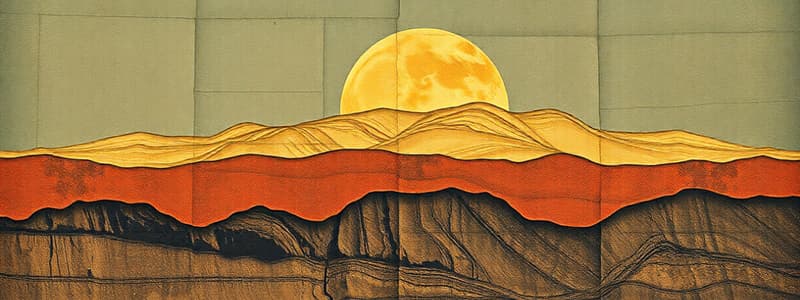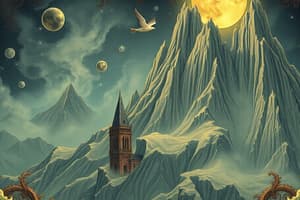Podcast
Questions and Answers
What is the primary material that makes up oceanic crust?
What is the primary material that makes up oceanic crust?
- Granite
- Limestone
- Basalt (correct)
- Sandstone
How thick can continental crust vary?
How thick can continental crust vary?
- 20 to 60 miles
- 6 to 47 miles (correct)
- 10 to 30 miles
- 2 to 10 miles
What is a key feature of oceanic crust in relation to continental crust?
What is a key feature of oceanic crust in relation to continental crust?
- It is constantly sinking under continental crust. (correct)
- It is more stable and long-lasting.
- It is less dense and thicker.
- It consists mainly of metamorphic rocks.
Which theory describes the movement of Earth's outer shell over the mantle?
Which theory describes the movement of Earth's outer shell over the mantle?
What is the primary reason for geological events such as earthquakes and volcanic eruptions?
What is the primary reason for geological events such as earthquakes and volcanic eruptions?
What was a significant limitation of Alfred Wegener's theory of continental drift?
What was a significant limitation of Alfred Wegener's theory of continental drift?
Which major tectonic plate is the largest and primarily located under the ocean?
Which major tectonic plate is the largest and primarily located under the ocean?
In what way is continental crust different from oceanic crust?
In what way is continental crust different from oceanic crust?
What is the outermost layer of the Earth called?
What is the outermost layer of the Earth called?
Which layer of the Earth comprises about 68 percent of Earth's mass?
Which layer of the Earth comprises about 68 percent of Earth's mass?
What primarily makes up the outer core?
What primarily makes up the outer core?
What is unique about the inner core compared to the outer core?
What is unique about the inner core compared to the outer core?
Which of the following best describes the mantle?
Which of the following best describes the mantle?
Which property is NOT used as a basis for dividing the Earth's layers?
Which property is NOT used as a basis for dividing the Earth's layers?
What is the primary role of the Earth's outer core in relation to the magnetic field?
What is the primary role of the Earth's outer core in relation to the magnetic field?
What is the thickness of the Earth's crust approximately?
What is the thickness of the Earth's crust approximately?
Flashcards are hidden until you start studying
Study Notes
Earth's Lithosphere Overview
- The Earth's lithosphere is divided into layers based on physical and chemical properties.
- The crust is the outermost layer, comprising less than 1% of Earth's mass, composed mainly of rock types such as granite and basalt.
- The mantle, which makes up about 68% of Earth’s mass, is a mostly solid layer underneath the crust that flows slowly.
- The outer core is a liquid layer around the inner core, primarily made of iron and nickel.
- The inner core is a solid ball composed mainly of iron and nickel, with temperatures exceeding those of the Sun's surface.
Types of Crust
- Continental crust is thicker (between 6 to 47 miles) and less dense than oceanic crust, and is predominantly made of granite.
- Oceanic crust is thinner and denser, primarily composed of basalt, and continuously recycles at plate boundaries.
- Oceanic crust tends to be much younger than continental crust and sinks under it at plate boundaries, leading to geological events like earthquakes and volcanic eruptions.
Plate Tectonics
- The theory of plate tectonics explains that Earth's outer shell is divided into several plates that glide over the mantle.
- Developed between the 1950s and 1970s, this theory evolved from Alfred Wegener's initial concept of continental drift proposed in 1912.
- There are nine major tectonic plates: North American, Pacific, Eurasian, African, Indo-Australian, Australian, Indian, South American, and Antarctic.
- The Pacific Plate is the largest, covering approximately 39,768,522 square miles (103,000,000 square kilometers), mostly underwater.
Geological Processes
- The lithosphere plays a crucial role in Earth's geological processes, including the movement of tectonic plates, resulting in earthquakes and volcanic activity.
- Properties of the lithosphere, such as its rigidity and composition, influence its behavior and interactions with the underlying asthenosphere (the semi-fluid layer beneath the lithosphere).
- Differences between oceanic and continental crust significantly impact geological events and help explain the mechanisms of plate tectonics.
- The interaction between the oceanic and continental crust can trigger geological phenomena, including the formation of mountain ranges and ocean trenches.
Additional Information
- "Geography" derives from Greek words "geo" (Earth) and "graphos" (to write), meaning a description of Earth.
- Earth is the third planet from the Sun and the fifth largest in the solar system, recognized as the only known location with life-supporting environments.
Studying That Suits You
Use AI to generate personalized quizzes and flashcards to suit your learning preferences.




